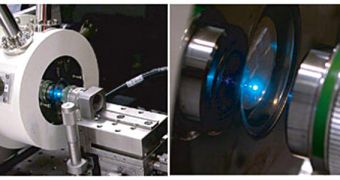In a groundbreaking innovation, physicists at the University of California in Berkeley (UCB) managed to exceed a barrier standing in the way of practical applications for plasmon lasers, and namely temperatures. This class of advanced devices can now operate at room temperatures.
These instruments have been proposed for a variety of uses, but thus far actually enlisting their help has proven to be a tremendously complex task. As such, physicists have been looking for ways of raising the temperatures at which these instruments operate for a long time.
It would now appear that the UCB team has had more success than others in this field, managing a “major step towards applications” for plasmon lasers, say investigators behind the work.
Details of achievement are published in the December 19 advanced online issue of the the esteemed scientific journal Nature Materials, Science Blog reports.
The principal investigator of the new study was UCB professor of mechanical engineering Xiang Zhang, who also holds an appointment as a faculty scientist at the US Department of Energy's (DOE) Lawrence Berkeley National Laboratory (Berkeley Lab).
“Plasmon lasers can make possible single-molecule biodetectors, photonic circuits and high-speed optical communication systems, but for that to become reality, we needed to find a way to operate them at room temperature,” Zhang explains.
The expert is also the director of the UCB Center for Scalable and Integrated Nanomanufacturing. This facility was established through the National Science Foundation’s (NSF) Nano-scale Science and Engineering Centers program.
“To operate properly, plasmon lasers need to be sealed in a vacuum chamber cooled to cryogenic temperatures as low as 10 Kelvins, or minus 441 degrees Fahrenheit, so they have not been usable for practical applications,” Renmin Ma says.
The expert is a post-doctoral researcher in Zhang’s lab, and also the co-lead author of the Nature Materials paper. Ma collaborated with Zhang in the development of a laser capable of generating light in a space just 5 nanometers wide last year.
“Lasers with a mode size of a single protein are a key milestone toward applications in ultra-compact light source in communications and biomedical diagnostics,” Ma reveals.
“The present square plasmon cavities not only can serve as compact light sources, but also can be the key components of other functional building-blocks in integrated circuits, such as add-drop filters, direction couplers and modulators,” the expert concludes.

 14 DAY TRIAL //
14 DAY TRIAL //